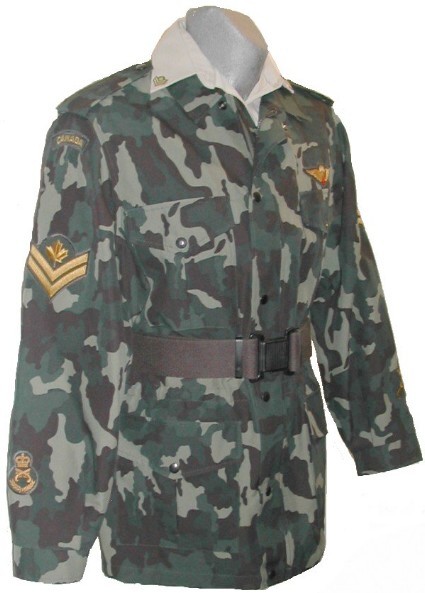How pixelated uniforms turned soldiers into walking targets
The U.S. outrages vets by shelling out $5 billion for ill-conceived camouflage that reportedly makes soldiers more visible
July 4, 2012
Article Link
The military has a major pixelation problem, and it doesn't involve computers. New reports suggest that the U.S. Army's pixelated camo uniform, introduced in 2004, is actually a monumental $5 billion blunder. Industry insiders are calling this a "fiasco," and many are enraged that the Army took eight years to address the issue. (See the uniforms at right and below.) Here's what you should know:
What's wrong with the uniforms?
The pattern is too easy to spot. Though the camouflage is supposed to help mask soldiers' presence in the desert and more moderate terrain, soldiers everywhere are criticizing the pixelated gray-green Universal Camouflage Pattern, or UPC, "for standing out almost anywhere it's been worn," says Erik German at The Daily. The mixture of the Army's gray-green color scheme with the pixel pattern turns out to be quite eye-catching — not a good quality in camouflage.
What kind of problems did these uniforms cause?
It's an "epic mistake that cost billions of dollars," says Molly Oswaks at Gizmodo, "and, ostensibly, many lives." Think about it, says Ubergizmo. Not only are the pixelated camouflage uniforms highly visible in their own right, but because the U.S. was bogged down fighting two wars, supply lines dragged, and many Army soldiers had the new pixelated gray-green fatigues, but old-school gear. So "soldiers were running around with desert-colored clothing, but their backpacks, vests, and body-armor would be colored differently with black or green," essentially telling enemies where to shoot. "At rifle distances," says German, "the problem posed by the dark gear over light clothing was as obvious as it was distressing."
How did this happen?
Apparently, Army commanders were "envious" of the dust-colored pixelated camouflage being developed for the Marine Corps, and rushed to demand a similar pattern in their own colors, instead of playing it safe with the classic cloudy globs traditionally used for Army camouflage. Things went haywire when officials insisted on using the Army's traditional grey-green color scheme, which, when paired with the pixels — not to mention darker gear — turned soldiers into walking targets. "Brand identity trumped camouflage utility," says military journalist Eric Graves. "That's what this really comes down to."
What happens next?
In Afghanistan, soldiers have been given replacement uniforms that offer better cover. But soldiers outside of Afghanistan are out of luck — at least until next year when the Army swaps out pixelated duds for state-of-the-art UPCs.
end
The U.S. outrages vets by shelling out $5 billion for ill-conceived camouflage that reportedly makes soldiers more visible
July 4, 2012
Article Link
The military has a major pixelation problem, and it doesn't involve computers. New reports suggest that the U.S. Army's pixelated camo uniform, introduced in 2004, is actually a monumental $5 billion blunder. Industry insiders are calling this a "fiasco," and many are enraged that the Army took eight years to address the issue. (See the uniforms at right and below.) Here's what you should know:
What's wrong with the uniforms?
The pattern is too easy to spot. Though the camouflage is supposed to help mask soldiers' presence in the desert and more moderate terrain, soldiers everywhere are criticizing the pixelated gray-green Universal Camouflage Pattern, or UPC, "for standing out almost anywhere it's been worn," says Erik German at The Daily. The mixture of the Army's gray-green color scheme with the pixel pattern turns out to be quite eye-catching — not a good quality in camouflage.
What kind of problems did these uniforms cause?
It's an "epic mistake that cost billions of dollars," says Molly Oswaks at Gizmodo, "and, ostensibly, many lives." Think about it, says Ubergizmo. Not only are the pixelated camouflage uniforms highly visible in their own right, but because the U.S. was bogged down fighting two wars, supply lines dragged, and many Army soldiers had the new pixelated gray-green fatigues, but old-school gear. So "soldiers were running around with desert-colored clothing, but their backpacks, vests, and body-armor would be colored differently with black or green," essentially telling enemies where to shoot. "At rifle distances," says German, "the problem posed by the dark gear over light clothing was as obvious as it was distressing."
How did this happen?
Apparently, Army commanders were "envious" of the dust-colored pixelated camouflage being developed for the Marine Corps, and rushed to demand a similar pattern in their own colors, instead of playing it safe with the classic cloudy globs traditionally used for Army camouflage. Things went haywire when officials insisted on using the Army's traditional grey-green color scheme, which, when paired with the pixels — not to mention darker gear — turned soldiers into walking targets. "Brand identity trumped camouflage utility," says military journalist Eric Graves. "That's what this really comes down to."
What happens next?
In Afghanistan, soldiers have been given replacement uniforms that offer better cover. But soldiers outside of Afghanistan are out of luck — at least until next year when the Army swaps out pixelated duds for state-of-the-art UPCs.
end


